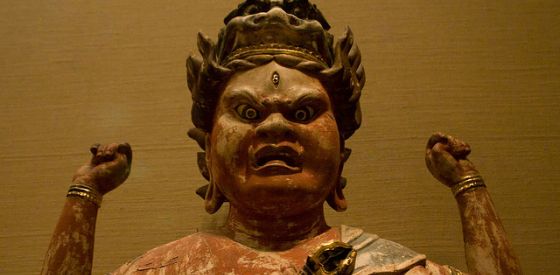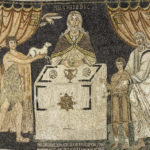We run our website the way we wished the whole internet worked: we provide high quality original content with no ads. We are funded solely by your direct support. Please consider supporting this project.

Cruciform Aikido Pt 1: Jesus and the Violent God
Note: Today, we are beginning a 4-part series on the subject of divine judgement called “Cruciform Aikido.” We will be publishing this once a week alongside Greg’s introduction to ReKnew series.
When most people think of God judging sinners, they imagine an angry God who acts violently as he vents his wrath and brings vengeance on people. Many base this understanding on various portraits of God judging people in the Old Testament (OT). (The book of Revelation also symbolically depicts God and Christ in violent ways, but that is a topic for a later blog.) There’s no question that some portraits of God in the OT depict him acting violently as he judges people. But these violent portraits are very hard to reconcile with the embodied revelation of a non-violent, enemy-loving God that we have in Jesus. Instead of calling on legions of angels to crush his enemies, Jesus offered himself up on their behalf, allowing them to crucify him while praying for their forgiveness with his last breath (Mt 26:53; Lk. 23:34). Since Jesus is the one and only perfect revelation of God’s essence (hupostasis, Heb 1:3), our understanding of God’s character and judgments ought to be anchored solely in him.
Moreover, since all Scripture is written to bear witness to Christ (Jn 5:39-40, 46-47; Lk 24: 44-45), the OT’s violent portraits of God ought to be interpreted through the lens of Christ. While all Scripture is divinely inspired, it was not intended to carry the same weight for all people throughout history. Hence, for example, while Jesus declared that John the Baptist was the greatest of all prophets leading up to him, Jesus declared that his own “testimony” was “weightier” (megas) than that of John (Jn 5:36). The revelation of God in Christ must therefore be given more weight than that of John and therefore be considered to carry more authority than any OT author prior to John. Though God certainly “breathed” (theopneustos; 2 Tim 3:16) through Old Testament authors, they did not know “the Word of God in fullness,” which was the “mystery” that had “been kept hidden for ages and generations” (Col. 1:25-26). This “mystery” was the truth of God’s humble, self-sacrificial, loving character–the character that was fully revealed only when God united himself to humanity in Christ and dwelt within his people by the Spirit of Christ–“Christ in you, the hope of glory” (Col. 1:26).
Given the supremacy of the revelation of God in Christ, we must consider the cross to be the quintessential revelation of God’s judgment. And as we will show in the next few blogs, this revelation means that the nature of God’s judgment is very different from the violent understanding that some OT authors had, and that many people today have.
Image by Orin Zebest. Used with Permission. Sourced via Flickr.
Category: General
Tags: Cruciform Theology, Old Testament, Violence
Related Reading

Would God Kill a Baby To Teach Parents a Lesson?
Question: We have a group of guys that are going through your book “Is God to Blame” and a question came up that I would be curious how you would look at it. In the beginning of the book you ask the question “do you really think that God kills babies to teach parents a lesson?”…

Podcast: Is There a Moral Difference Between Killing and Murder?
Greg argues against C.S. Lewis’ claim that not all killing is murder. http://traffic.libsyn.com/askgregboyd/Episode_0223.mp3

Cross Centered Q&A
For those within driving distance of Saint Paul, MN, we invite you to join us for a free event. Greg will be discussing his new book Crucifixion of the Warrior God with Bruxy Cavey (Pastor of The Meeting House in Toronto) and Dennis Edwards (Pastor of Sanctuary Covenant Church in Minneapolis). Don’t miss this opportunity to hear Greg…

Podcast: Doesn’t Claiming that the Old Testament Writers were Sometimes Wrong Inevitably Lead to a Slippery Slope?
Greg talks about cataphatic prayer and the role of the imagination. http://traffic.libsyn.com/askgregboyd/Episode_0470.mp3

If Jesus Is the Whole Point, Then What’s the Point of the Old Testament? (podcast)
Greg considers the role of the Old Testament in Christian faith. Episode 554 http://traffic.libsyn.com/askgregboyd/Episode_0554.mp3

The Centrality of Christ in Hebrews, Part 2
The intensely Christocentric reading of the Old Testament that I introduced in the previous post is reflected throughout the book of Hebrews. Here I want to cite two more examples of how this writer saw Christ at the center of the OT. Hebrews 7 Here the author argues for the superiority of Christ’s priesthood over…
